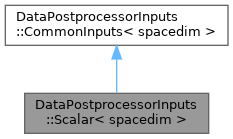 |
Reference documentation for deal.II version GIT relicensing-437-g81ec864850 2024-04-19 07:30:02+00:00
|
 |
Reference documentation for deal.II version GIT relicensing-437-g81ec864850 2024-04-19 07:30:02+00:00
|
#include <deal.II/numerics/data_postprocessor.h>

Public Member Functions | |
| template<int dim> | |
| void | set_cell (const typename DoFHandler< dim, spacedim >::cell_iterator &cell) |
| template<int dim> | |
| void | set_cell_and_face (const typename DoFHandler< dim, spacedim >::cell_iterator &cell, const unsigned int face_number) |
| template<int dim> | |
| DoFHandler< dim, spacedim >::cell_iterator | get_cell () const |
| unsigned int | get_face_number () const |
Public Attributes | |
| std::vector< double > | solution_values |
| std::vector< Tensor< 1, spacedim > > | solution_gradients |
| std::vector< Tensor< 2, spacedim > > | solution_hessians |
| std::vector< Tensor< 1, spacedim > > | normals |
| std::vector< Point< spacedim > > | evaluation_points |
Private Attributes | |
| std::any | cell |
| unsigned int | face_number |
A structure that is used to pass information to DataPostprocessor::evaluate_scalar_field(). It contains the values and (if requested) derivatives of a scalar solution variable at the evaluation points on a cell or face. (This class is not used if a scalar solution is complex-valued, however, since in that case the real and imaginary parts are treated separately – resulting in vector-valued inputs to data postprocessors, which are then passed to DataPostprocessor::evaluate_vector_field() instead.)
Through the fields in the CommonInputs base class, this class also makes available access to the locations of evaluations points, normal vectors (if appropriate), and which cell data is currently being evaluated on (also if appropriate).
Definition at line 321 of file data_postprocessor.h.
|
inherited |
Set the cell that is currently being used in evaluating the data for which the DataPostprocessor object is being called.
This function is not usually called from user space, but is instead called by DataOut and similar classes when creating the object that is then passed to DataPostprocessor.
|
inherited |
Set the cell and face number that is currently being used in evaluating the data for which the DataPostprocessor object is being called. Given that a face is required, this function is meant to be called by a class such as DataOutFaces.
This function is not usually called from user space, but is instead called by DataOutFaces and similar classes when creating the object that is then passed to DataPostprocessor.
|
inherited |
Query the cell on which we currently produce graphical output. See the documentation of the current class for an example on how to use this function.
|
inherited |
Query the face number on which we currently produce graphical output. See the documentation of the current class for an example on how to use the related get_cell() function that is meant to query the cell currently being worked on.
This function is intended for use when producing graphical output on faces, for example through the DataOutFaces class.
Definition at line 32 of file data_postprocessor.cc.
| std::vector<double> DataPostprocessorInputs::Scalar< spacedim >::solution_values |
An array of values of the (scalar) solution at each of the evaluation points used to create graphical output from one cell, face, or other object.
Definition at line 328 of file data_postprocessor.h.
| std::vector<Tensor<1, spacedim> > DataPostprocessorInputs::Scalar< spacedim >::solution_gradients |
An array of gradients of the (scalar) solution at each of the evaluation points used to create graphical output from one cell, face, or other object.
This array is only filled if a user-derived class overloads the DataPostprocessor::get_needed_update_flags(), and the function returns (possibly among other flags) UpdateFlags::update_gradients. Alternatively, a class derived from DataPostprocessorScalar, DataPostprocessorVector, or DataPostprocessorTensor may pass this flag to the constructor of these three classes.
Definition at line 343 of file data_postprocessor.h.
| std::vector<Tensor<2, spacedim> > DataPostprocessorInputs::Scalar< spacedim >::solution_hessians |
An array of second derivatives of the (scalar) solution at each of the evaluation points used to create graphical output from one cell, face, or other object.
This array is only filled if a user-derived class overloads the DataPostprocessor::get_needed_update_flags(), and the function returns (possibly among other flags) UpdateFlags::update_hessians. Alternatively, a class derived from DataPostprocessorScalar, DataPostprocessorVector, or DataPostprocessorTensor may pass this flag to the constructor of these three classes.
Definition at line 358 of file data_postprocessor.h.
|
inherited |
An array of vectors normal to the faces of cells, evaluated at the points at which we are generating graphical output. This array is only used by the DataOutFaces class, and is left empty by all other classes for which the DataPostprocessor framework can be used. In the case of DataOutFaces, the array contains the outward normal vectors to the face, seen from the interior of the cell.
This array is only filled if a user-derived class overloads the DataPostprocessor::get_needed_update_flags(), and the function returns (possibly among other flags) UpdateFlags::update_normal_vectors. Alternatively, a class derived from DataPostprocessorScalar, DataPostprocessorVector, or DataPostprocessorTensor may pass this flag to the constructor of these three classes.
Definition at line 214 of file data_postprocessor.h.
|
inherited |
An array of coordinates corresponding to the locations at which we are generating graphical output on one cell.
This array is only filled if a user-derived class overloads the DataPostprocessor::get_needed_update_flags(), and the function returns (possibly among other flags) UpdateFlags::update_quadrature_points. Alternatively, a class derived from DataPostprocessorScalar, DataPostprocessorVector, or DataPostprocessorTensor may pass this flag to the constructor of these three classes.
Definition at line 236 of file data_postprocessor.h.
|
privateinherited |
The place where set_cell() stores the cell. Since the actual data type of the cell iterator can be many different things, the interface uses std::any here. This makes assignment in set_cell() simple, but requires knowing the data type of the stored object in get_cell().
Definition at line 295 of file data_postprocessor.h.
|
privateinherited |
The place where set_cell_and_face() stores the number of the face being worked on.
Definition at line 301 of file data_postprocessor.h.